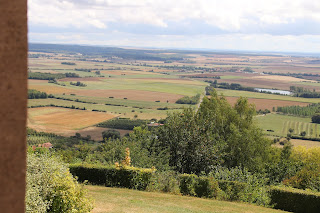Les Jardins du Mess
Verdun, France
72 F, sunny
One hundred
years ago, our countrymen came to France to join the Great War. After brief
training, many divisions faced their first big test, the St. Mihiel Offensive
in September 1918. Over 500,000 American men and 110,000 French pursued General
Pershing’s goal of breaking through the German line to move toward the city of
Metz. Despite the constant shelling by the Germans and the air fights, the
American attack was successful and served to establish what the American Army
could do.
Today we
covered the St. Mihiel Salient, the areas that William Hendershott, Arthur
Manness, Archie Harvey, Roy Hall, Lynn Price, and Robert Arnold, marched
through and fought through, the most horrific battle American forces had ever
been in. They pushed through trees, encountered pill boxes, horrific shelling,
the explosions, the mud, the smoke, the rubble.
When our bus
dropped us off at the Eparges Spur,
we saw the remnants of huge mine craters, shell explosions, and trenches. Mike called it a blood soaked battlefield--an area where mines were much used. War
had been going on in this area for four years as the Americans came in. It was
stunning to see the plain below, the American position.
Remnants of trenches still...
A shell or mine crater-photos do not do them justice because the viewer cannot determine depth
This monument depicts Mother Mary cradling a soldier--another Pieta like pose. Every single village or town in France has at least one statue/monument dedicated to the soldiers of World War I. The art of war.
Our bus continued
on as Mike explained each division’s position at St. Mihiel and what happened each day. We
learned that George Patton made his name here, the first American use of tanks. Mike G mentioned there will be a "Patton Day" in September this year in St. Mihiel. We saw "General George Patton Pilsner" beer that is being made in the Czech Republic. I wish I could have purchased a souvenir bottle, but our luggage was already at max!
Mont Sec Monument is one of the most dramatic sites as it sits on one of the highest points in France, a perfect defensive position for the Germans. Today the tall columns can be seen for miles and when one looks out from its platform one can see the grand valley, the sight of such horror in 1918.
Mont Sec Monument is one of the most dramatic sites as it sits on one of the highest points in France, a perfect defensive position for the Germans. Today the tall columns can be seen for miles and when one looks out from its platform one can see the grand valley, the sight of such horror in 1918.
Mont Sec Monument
The valley as seen from Mont Sec--in September 1918 over 550,000 Americans and 110,000 French filled this valley. Until the Meuse Argonne Offensive a few weeks later,
St. Mihiel was considered the laragest battle in U.S. history.
We passed
the area of several villages that no longer exist. Other villages and towns were devastated during the war, so the French used the stones to rebuild from the rubble. After the war, Germany was
required to pay reparation to rebuild many towns and villages, but not all.
When we reached Euville, Mike had arranged for all of us to have lunch together at Restaurant Le Provencal. Our three course lunch was a petite salad and petite meatloaf-type pate, turkey with mushrooms and creamy potatoes, and cooked julienne carrots, parsnips, and zucchini, with chocolate mousse for dessert. The best meal so far! We met Mike G and his wife Shannon who are now making their home in France--Mike G is also very knowledgable about the Great War and is considered an American ambassador to St. Mihiel.
When we reached Euville, Mike had arranged for all of us to have lunch together at Restaurant Le Provencal. Our three course lunch was a petite salad and petite meatloaf-type pate, turkey with mushrooms and creamy potatoes, and cooked julienne carrots, parsnips, and zucchini, with chocolate mousse for dessert. The best meal so far! We met Mike G and his wife Shannon who are now making their home in France--Mike G is also very knowledgable about the Great War and is considered an American ambassador to St. Mihiel.
After lunch,
we traveled on to St. Mihiel American Cemetery, a beautifully maintained
cemetery of 40.5 acres in Thiaucourt, France. The majority of the 4,153 soldiers
buried here, as well as the 284 missing in action, died in the St. Mihiel
Salient that threatened Paris.
Today we
honored both William Hendershott at his gravesite, as well as Arthur Manness. Tim
and I felt privileged to do that for the Veterans of Foreign Wars Post #374,
named for both of these men from Arcade, New York. Everyone listened as we said
a few words of our respect for these men and all of our tour mates, 42 witnessess, shared in a
moment of silence and reflection.
The grave of William Hendershott, 78th Division, 303rd Engineer Regiment
St. Mihiel American Cemetery / 2018
William Hendershott's mother in 1932 at the same grave of her son in St. Mihiel American Cemetery
Military Service Veterans Jim C, Tim, Ed M, and Erik K after
they lowered the flag at St. Mihiel American Cemetery
TK's Takes:








Wonderful! What a moving day this must have been for you. Thanks for adding our heroes to your heroes. ❤
ReplyDeleteThank you, Carole-I was honored to do this for William Hendershott and Arthur Manness.
ReplyDelete